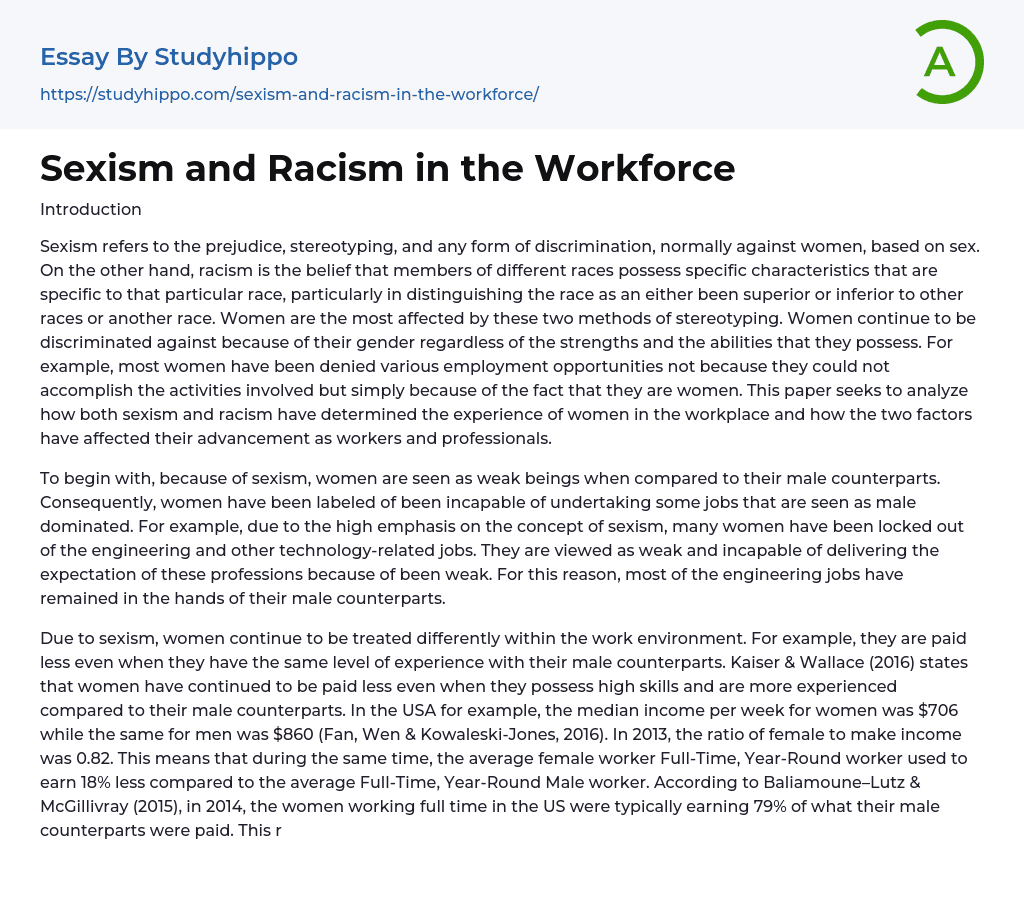Introduction
Sexism refers to the prejudice, stereotyping, and any form of discrimination, normally against women, based on sex. On the other hand, racism is the belief that members of different races possess specific characteristics that are specific to that particular race, particularly in distinguishing the race as an either been superior or inferior to other races or another race. Women are the most affected by these two methods of stereotyping. Women continue to be discriminated against because of their gender regardless of the strengths and the abilities that they possess. For example, most women have been denied various employment opportunities not because they could not accomplish the activities involved but simply because of the fact that they are women. This paper seeks to analyze how both sexism and racism have determined the experience of wo
...men in the workplace and how the two factors have affected their advancement as workers and professionals.
To begin with, because of sexism, women are seen as weak beings when compared to their male counterparts. Consequently, women have been labeled of been incapable of undertaking some jobs that are seen as male dominated. For example, due to the high emphasis on the concept of sexism, many women have been locked out of the engineering and other technology-related jobs. They are viewed as weak and incapable of delivering the expectation of these professions because of been weak. For this reason, most of the engineering jobs have remained in the hands of their male counterparts.
Due to sexism, women continue to be treated differently within the work environment. For example, they are paid less even when they have the same level of experience with their mal
counterparts. Kaiser & Wallace (2016) states that women have continued to be paid less even when they possess high skills and are more experienced compared to their male counterparts. In the USA for example, the median income per week for women was $706 while the same for men was $860 (Fan, Wen & Kowaleski-Jones, 2016). In 2013, the ratio of female to make income was 0.82. This means that during the same time, the average female worker Full-Time, Year-Round worker used to earn 18% less compared to the average Full-Time, Year-Round Male worker. According to Baliamoune–Lutz & McGillivray (2015), in 2014, the women working full time in the US were typically earning 79% of what their male counterparts were paid. This research shows that women continue to be underpaid when compared to males even in the most developed nations.
Research also shows that racism is also used in discriminating women in workplaces. For example, non-white women are poorly paid in the USA when compared to the white women workers. The main reason most non-white women are poorly paid in the United States is that they are poorly educated when compared to the white women. Many women of color are not much educated when compared to their white counterparts and, therefore, they lack skills and expertise in various fields of specialization (Shaikh, Papanikolaou & Wiener, 2014). For this reason, women of color continue to pay lesser when compared to the whites.
These factors have affected the advancement of women as workers and professionals in different ways. For example, women have lost the motivation to further their studies because of being demoralized in the work environment (Albelda & Carr,
2014). Even though most women have acquired the same level of skills as their male counterparts, they continue to be paid less. For this reason, most women have been demoralized and have decided to venture in other undertakings instead of furthering their studies. As a result, the do not have the update skills that are required in varying out various duties within organizations. Lack of sufficient skills mean that women may continue being paid less and fail to get job promotions.
Racism is also affecting the advancement of women carriers and professions. Women of color continue to get peanuts in the US regardless of their level of expertise. The women are discriminated against because of their race regardless of the level of expertise. For this reason, most of the women of color have given up on the advancement of their careers by deciding not to further their education. In addition, because of the poor treatment in the workplace, most women of color have lost hope in been employment and they have established businesses of their own.
Conclusion
Sexism and racism are among the factors that affect labor today. Most people in the job market have continued to be discriminated against based on their color and gender. Women are the most affected. People regard women as weak beings and for this reason; they have been discriminated from various jobs that are viewed as male-dominated. For example, most engineering and technology-related jobs continue to be dominated by men even during a time when men have enough skills to run these professions. On the other hand, women of color have continued to be discriminated against in job market. For example, research
shows that it is a challenge for women of color to get jobs in the United States even with the required qualifications.
References
- Albelda, R., & Carr, M. (2014). Double Trouble: US Low-Wage and Low-Income Workers, 1979–2011. Feminist Economics, 20(2), 1-28.
- Baliamoune–Lutz, M., & McGillivray, M. (2015). The impact of gender inequality in education on income in Africa and the Middle East. Economic Modelling, 471-11
- Fan, J. X., Wen, M., & Kowaleski-Jones, L. (2016). Tract- and county-level income inequality and individual risk of obesity in the United States. Social Science Research, 5575-82.
- Kaiser, R. B., & Wallace, W. T. (2016). Gender bias and substantive differences in ratings of leadership behavior: Toward a new narrative. Consulting Psychology Journal: Practice And Research, 68(1), 72-98
- Shaikh, A., Papanikolaou, N., & Wiener, N. (2014). Race, gender and the econophysics of income distribution in the USA. Physica A: Statistical Mechanics And Its Applications, 41554-60.




